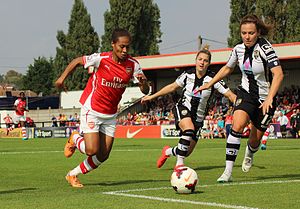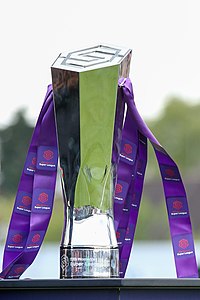
A | B | C | D | E | F | G | H | CH | I | J | K | L | M | N | O | P | Q | R | S | T | U | V | W | X | Y | Z | 0 | 1 | 2 | 3 | 4 | 5 | 6 | 7 | 8 | 9
 | |
| Founded | March 2010 Displaced Premier League National as level 1 division |
|---|---|
| First season | 2011 |
| Country | England |
| Confederation | UEFA |
| Number of teams | 12 |
| Level on pyramid | 1 |
| Relegation to | Women's Championship |
| Domestic cup(s) | Women's FA Cup |
| League cup(s) | FA Women's League Cup |
| International cup(s) | UEFA Champions League |
| Current champions | Chelsea (6th title) (2022–23) |
| Most championships |
|
| Most appearances | Sophie Ingle (189) |
| Top goalscorer | Vivianne Miedema (79) |
| TV partners | Sky Sports BBC Sport see broadcasting for international |
| Website | womensleagues.thefa.com |
| Current: 2023–24 Women's Super League | |
The Women's Super League (WSL), known as the Barclays Women's Super League (BWSL) for sponsorship reasons, is the highest league of women's football in England. Established in 2010, it is run by the Football Association and features twelve fully professional teams.
The league replaced the FA Women's Premier League National Division as the highest level of women's football in England, with eight teams competing in the inaugural 2011 season. In the WSL's first two seasons, there was no relegation from the division.
The WSL discarded the winter football season for six years, between 2011 and 2016, playing through the summer instead (from March until October). Since 2017–18, the WSL has operated as a winter league running from September to May, as was traditional before 2011.
From 2014 to 2017–18, the Women's Super League consisted of two divisions – FA WSL 1 and FA WSL 2 – and brought a promotion and relegation system to the WSL. Ahead of the 2018–19 season, the second division was renamed the FA Women's Championship.
The WSL champions, runners-up and third-placed team qualify for the UEFA Women's Champions League the following season. The current Women's Super League champions are Chelsea, who won their sixth title in the 2022–23 season.
In November 2023, all 24 Women's Super League and Women's Championship clubs had unanimously agreed to form a new organisation, named NewCo, to run the women's professional game in England, taking over from the FA.
History
The FA WSL was due to start in 2010 to replace the FA Women's Premier League National Division as the top level of women's football in England but was deferred for a year due to the global economic downturn.[1] Sixteen clubs applied for 8 places in the inaugural season of the league: Arsenal, Barnet, Birmingham City, Bristol Academy, Chelsea, Colchester United, Doncaster Rovers Belles, Everton, Leeds Carnegie, Leicester City, Lincoln Ladies, Liverpool, Millwall Lionesses, Newcastle United, Nottingham Forest, and Sunderland.[2] Leeds Carnegie later withdrew their application.[3] Women's Premier League clubs Blackburn Rovers and Watford declined to apply.[4] FA Chief Executive Ian Watmore described the creation of the league as a "top priority" in February 2010.[5]
The inaugural WSL season kicked off on 13 April 2011 — at Imperial Fields, Chelsea's home ground — with a match between Chelsea and Arsenal, which Chelsea lost 1–0.[6]

For the 2014 season, a second division was created named FA WSL 2, with nine teams and one team being relegated from the WSL 1. WSL 1 remained as eight teams, with the WSL 2 having ten teams.[7][8][9][10] The new WSL 1 licence was awarded to Manchester City. Doncaster Rovers Belles were relegated to the WSL 2. They appealed against their demotion but were unsuccessful.[11]
In December 2014, the FA WSL announced a two-year plan to expand the WSL 1 from an eight to a ten-team league. Two teams were promoted from the WSL 2 at the end of the 2015 season, while one team was relegated to the WSL 2 with the same happening at the end of the 2016 season.[12][13] Also, for the first time, a team from the FA Women's Premier League earned a promotion to WSL 2, effectively connecting the WSL to the rest of the English women's football pyramid.[14]
The FA announced in July 2016 that the league would move from a summer league format to a winter league, in line with the traditional football calendar in England, with matches played from September to May the following year. A shortened bridging season took place, branded as the FA WSL Spring Series, with teams playing each other once from February to May 2017.[15]
Following the 2017–18 FA WSL season, WSL 1 was renamed back to the FA Women's Super League, becoming a fully professional league for the first time, with eleven teams for the 2018–19 season.[16][17] Teams had to re-apply for their licence to earn their place in the league, requiring clubs to offer their players a minimum 16-hour a week contract and to form a youth academy as compulsory for the new licence criteria. Sunderland was moved down to tier 3 in the women's football pyramid after not receiving a licence whilst Brighton & Hove Albion and West Ham United were added to the league.[18]
The league was extended to twelve teams for the 2019–20 season, with Yeovil Town relegated after going into administration and being replaced by Manchester United and Tottenham Hotspur, who gained promotion from the Championship.[19]
In May 2020 the league was curtailed by the COVID-19 pandemic. Chelsea were declared champions of the season based on a points-per-game average.[20]
At the conclusion of the 2020–21 season, four first-team managers resigned from their positions at WSL clubs Birmingham, Manchester United, Arsenal, and Aston Villa. Birmingham's outgoing manager Carla Ward questioned the commitment of some of the clubs involved in WSL,[21] whilst Manchester United's outgoing manager Casey Stoney allegedly quit because of unresolved issues surrounding lack of training facilities and other infrastructure.[22]
In November 2023, it was announced that all 24 Women's Super League and Women's Championship clubs had unanimously agreed to form a new organisation to run the women's professional game in England, taking over from the FA. The organization is called NewCo, and Nikki Doucet has been named CEO.[23][24]
Competition structure
| Season(s) | Teams |
|---|---|
| 2011–2015 | 8 |
| 2016–2017 | 9 |
| 2017–18 | 10 |
| 2018–19 | 11 |
| 2019–20 onward | 12 |
The FA Women's Super League currently consists of twelve clubs. Initially the league was described as professional, with the top four players on each team being paid an annual salary in excess of £20,000.[25] However, in November 2010 it was confirmed that the WSL would be semi-professional, with only a "handful" of top players full-time.[26] Clubs' annual wage bills were expected to be approximately one-tenth of those in the now-defunct American Women's Professional Soccer.[26]
The 2011 season included a mid-season break from 12 May 2011, to allow for the 2011 FIFA Women's World Cup. The season then resumed in early July, finishing in August 2011.[27]
After the league fixtures, the teams compete for a knock-out cup competition, the FA WSL Continental Cup.[28] For the 2014 season, the teams were placed into three regional groups of six. The group winners and best-performing runners-up all advanced to a knockout semi-final.[29] Since the 2015 season, the WSL Continental Cup have been played simultaneously with the league season.
Following a review, the FA announced in September 2017 that a restructuring of the league and its licensing criteria would follow from the 2017–18 season with a goal of a fully professional top division of between 8 and 14 teams and a second division of up to 12 semi-professional teams.[30] For the 2018–19 season, the league became fully professional.[16]
Clubs
The following twelve clubs are competing in the 2023–24 season:
| Team | Location | Ground | Capacity | 2022–23 position |
|---|---|---|---|---|
| Arsenal | Borehamwood | Meadow Park | 4,502 | 3rd |
| Aston Villa | Walsall | Bescot Stadium | 11,000 | 5th |
| Brighton & Hove Albion | Crawley | Broadfield Stadium | 6,134 | 11th |
| Bristol City | Bristol | Ashton Gate Stadium | 27,000 | WC, 1st |
| Chelsea | Kingston upon Thames | Kingsmeadow | 4,850 | 1st |
| Everton | Liverpool | Walton Hall Park | 2,200 | 6th |
| Leicester City | Leicester | King Power Stadium | 32,261 | 10th |
| Liverpool | Birkenhead | Prenton Park | 16,587 | 7th |
| Manchester City | Manchester | Academy Stadium | 7,000 | 4th |
| Manchester United | Leigh | Leigh Sports Village | 12,000 | 2nd |
| Tottenham Hotspur | Leyton | Brisbane Road | 9,271 | 9th |
| West Ham United | Dagenham | Victoria Road | 6,078 | 8th |
Players

In the first season of the WSL clubs were subject to a squad cap of 20 players. This proved unpopular with both managers and players.[31][32] Ahead of the 2012 season, the rule was reviewed and the cap increased to 23 players.[33] Players from outside the European Union, like their male counterparts, are subject to Home Office work permit regulations.[34]
The FA said in April 2012 that the salary rule of allowing only four players per team to earn over £20,000 and that all clubs are paid £70,000 per season from a Club Development Fund should limit any financial "imbalance" between clubs.[35] However, the introduction of a genuine salary cap remained under consideration for 2013 and beyond.[34] Doncaster manager John Buckley revealed that his club lost Rachel Williams and other players to Birmingham City because he was working to a budget eight times smaller than that enjoyed by Birmingham.[36]
When the 2012 WPS season was cancelled in the United States, Lincoln Ladies manager Glen Harris said that the next destination of that league's British players would be decided by "pounds, shillings and pence."[37] Ultimately Kelly Smith, Alex Scott and Gemma Davison all joined Arsenal,[38][39] while Ifeoma Dieke and Anita Asante joined the Swedish Damallsvenskan in preference to the WSL.
On 20 May 2023, Reading manager Kelly Chambers noted that the team — the only WSL club not affiliated with a men's Premier League club – struggled to compete with a smaller budget for wages than women's sides with Premier League backing. She cited the £250,000 fee paid by Tottenham Hotspur for Bethany England, while some Reading staff were required to work multiple roles from lack of investment by its affiliated men's side in the EFL Championship.[40]
Champions

By season
Teams in just bold indicate doubles with the Women's FA Cup. Teams in bold and in italics indicate trebles with the Women's FA Cup and FA Women's League Cup.
| Year | Winners | Runners-up | Third place | Top goalscorer | |
|---|---|---|---|---|---|
| Player | Goals | ||||
| 2011 | Arsenal | Birmingham City | Everton | 14 | |
| 2012 | Arsenal | Birmingham City | Everton | 11 | |
| 2013 | Liverpool | Bristol Academy | Arsenal | 13 | |
| 2014 | Liverpool | Chelsea | Birmingham City | 8 | |
| 2015 | Chelsea | Manchester City | Arsenal | 12 | |
| 2016 | Manchester City | Chelsea | Arsenal | 9 | |
| 2017 (Spring Series)[a] | Chelsea | Manchester City | Arsenal | 6 | |
| 2017–18 | Chelsea | Manchester City | Arsenal | 15 | |
| 2018–19 | Arsenal | Manchester City | Chelsea | 22 | |
| 2019–20[b] | Chelsea | Manchester City | Arsenal | 16 | |
| 2020–21 | Chelsea | Manchester City | Arsenal | 21 | |
| 2021–22 | Chelsea | Arsenal | Manchester City | 20 | |
| 2022–23 | Chelsea | Manchester United | Arsenal | 22 | |
By team
| Club | Winners | Runners-up | Years won | Years runners-up |
|---|---|---|---|---|
| Chelsea | 6 | 2 | 2015, 2017–18, 2019–20, 2020–21, 2021–22, 2022–23 | 2014, 2016 |
| Arsenal | 3 | 1 | 2011, 2012, 2018–19 | 2021–22 |
| Liverpool | 2 | 0 | 2013, 2014 | |
| Manchester City | 1 | 5 | 2016 | 2015, 2017–18, 2018–19, 2019–20, 2020–21 |
| Birmingham City | 0 | 2 | 2011, 2012 | |
| Bristol Academy | 0 | 1 | 2013 | |
| Manchester United | 0 | 1 | 2022–23 |
- Notes
- ^ The FA WSL Spring Series was an interim edition and is not recognised as an official title as it has not been played throughout the whole season.[41][42][43]
- ^ Due to the COVID-19 pandemic, the season ended early and the league was decided on a points-per-game basis.
Records
- As of 27 May 2023. All current WSL players are in bold.
Most appearances
| Rank | Player | Apps | Position | First app | Last app | Ref. |
|---|---|---|---|---|---|---|
| 1 | 183 | Defender | 2011 | 2022–23 | [44] | |
| 2 | 182 | Midfielder | 2011 | 2022–23 | [45] | |
| 3 | 178 | Midfielder | 2012 | 2022–23 | [46] | |
| 4 | 177 | Defender | 2011 | 2022–23 | [47] | |
| 5 | 174 | Midfielder | 2011 | 2021–22 | [48] | |
| 6 | 173 | Defender | 2011 | 2022–23 | [49] | |
| 7 | 171 | Defender | 2011 | 2022–23 | [50] | |
| 8 | 168 | Midfielder | 2011 | 2022–23 | [51] | |
| Defender | 2011 | 2022–23 | [52] | |||
| 10 | 167 | Goalkeeper | 2011 | 2022–23 | [53] |
